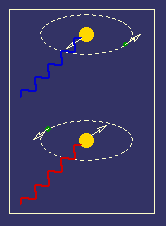Extrasolar Planet Detection with the AFOE

Detection of a high-eccentricity low-mass companion to HD 89744
Introduction
Extrasolar planet detection is the search for planets around other stars than
our Sun. Several techniques are being used to detect planets around other
suns; they are discussed in a
Scientific American Exploration Web page.
 The AFOE has been designed to provide the
required precison and stability to detect the wobble induced on the star by
the presence of a planet.
The AFOE has been designed to provide the
required precison and stability to detect the wobble induced on the star by
the presence of a planet.
Indeed, both the planet and the star revolve around their common
center of gravity. While the center of gravity is very close to the center of
the star, it is not exactly at the center of the star.
Therefore the star wobbles around the center of gravity with the same
period as the planet. The more massive the planet and the closer the orbit the
larger will be the amplitude of the wobble.
By measuring the doppler shift caused by the
wobble of the star on the light it emits, we can detect such a periodic
motion.
This wobble is very small, therefore very stable and precise measurements are
needed to make such a detection. The amplitude if the wobble induced by
Jupiter on the Sun is 13 meters per second, or 29 miles per hour (1 m/s is
2.237 mph).
Animations for some simulations of orbit are now
available.
Results
The AFOE has developed a planet detection
program since 1992. As of 1995, the instrument configuration became stable
enough to achieve the required precision.
The AFOE extrasolar program has since
- detected a high-eccentricity low-mass
companion to HD 89744.

- detected a multiple planetary system around
the star Upsilon Andromedae.
- detected a planet around the star rho
Coronae Borealis.
- confirmed the presence of a 3.9 Jupiter mass
planet around the star tau Boötis.
- confirmed the presence of a 0.5 Jupiter mass
planet around the star 51 Pegasi.
- Presented at the 194th AAS meeting:
"Evidence for a System of
planets orbiting upsilon Andromedae",
a poster presentation showing the evidence for a system of 3 giant planets
around the star Upsilon Andromedae and the results of dynamical stability
calculations to further contrain the properties of the system.
- Published in The Astrophysical Journal Letter (v. 494,
p. L85)
"A Search for Line Shape
and Depth Variations in 51 Pegasi and Tau Boötis"
,
where our analysis of spectroscopic observations of 51 Pegasi and tau
Boötis with the AFOE show no periodic changes in the shapes of their
line profiles; these results for 51 Peg are in significant conflict with
those reported by Gray and Hatzes (1997).
- Published in The Astrophysical Journal Supplement (v. 117,
p. 563-85)
"Exoplanets or Dynamic
Atmospheres? The Radial Velocity and Line Shape Variations of 51Pegasi
and Tau Boötis. "
,
where we present expanded and detailed analysis of spectroscopic
observations of 51 Pegasi and tau Boötis, that show no evidence for
periodic line-shape changes,at a level that rules out pulsations as the
source of the radial velocity variability.
- Presented a talk at
IAU Colloquium 170 on Precise Stellar Radial Velocities
,
Victoria, BC, June 1998:
The advanced fiber-optic echelle (AFOE) and extrasolar planet
searches,
where we discuss the status of the instrument, as well as an upgrade to
the instrument, a Fabry-Perot reference, which may prove important both for
the AFOE and for all Precision Radial Velocity (PRV) facilities.
- Presented a poster at
IAU Colloquium 170 on Precise Stellar Radial Velocities
,
Victoria, BC, June 1998:
"The Planet Orbiting RhoCrB"
,
where we present updated orbital parameters of rhoCrB, and discuss various
planet formation scenarios in view of the observational constrains.
- Presented a poster at
The 10th Cambridge Workshop on Cool Stars, Stellar Systems, and the Sun
,
Cambridge, July 1997:
"51 Pegasi and Tau Boötis:
Planets or Pulsations",
where we discuss the suggestion (Gray 1997) that the radial velocity
variations observed in the spectra of 51 Pegasi are the result of stellar
pulsations as opposed to the reflex motion due to an orbital companion.
References
- Exoplanet
Research with the Advanced Fiber Optic Echelle, Korzennik et
al., 1997, poster presented at the 10th Cool Star Meeting (July 1997,
Cambridge, MA
- The AFOE Program for Extra Solar Planet
Research, Noyes et al., 1997, in "Planets Beyond the Solar
System and the Next Generation of Space Missions", Space Telescope Science
Institute Workshop, P.A.S.P., in press.
- HD 3346., Noyes, R., Korzennik, S., Nisenson, P., Jha, S.,
Krockenberger, M., Brown, T., Kennelly, T., Rowland, C., Horner, S., 1996,
IAUCirc. 6316.
- Precise Radial Velocity Measurements of 51 Pegasi with the AFOE
Spectrograph Kennelly, E.J., Brown, T. M., Rowland, C., Horner, S.D.,
Korzennik, S.G., Krockenberger, M., Nisenson, P., Noyes, R.W., 1995, BAAS,
187, 7005.
Other Sites
This celestial map shows where to find 11
of the stars known to have planetary companions (and growing...).
A compressed PostScript version of the
map is also available.
 AFOE Home page.
AFOE Home page.
__________________________________________________
Sylvain G. Korzennik
(skorzennik@cfa.harvard.edu)
Adam Contos
(acontos@cfa.harvard.edu)
Last modified: Thu Jan 30 10:18:39 2003
 The AFOE has been designed to provide the
required precison and stability to detect the wobble induced on the star by
the presence of a planet.
The AFOE has been designed to provide the
required precison and stability to detect the wobble induced on the star by
the presence of a planet.

 The AFOE has been designed to provide the
required precison and stability to detect the wobble induced on the star by
the presence of a planet.
The AFOE has been designed to provide the
required precison and stability to detect the wobble induced on the star by
the presence of a planet.

 AFOE Home page.
AFOE Home page.